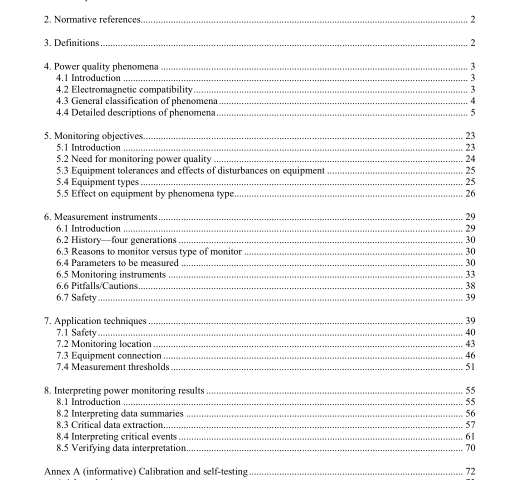IEEE 1159-2009 pdf download.IEEE Recommended Practice for Monitoring Electric Power Quality
4. Power quality phenomena
4.1 Introduction
The term power quality refers to a wide variety of electromagnetic phenomena that characterize the voltage and current at a given time and at a given location on the power system. This chapter amplifies the definitions of Clause 3 and the glossary in Annex B by providing technical descriptions and examples of the principal electromagnetic phenomena causing power quality problems. The increasing application of electronic equipment that can cause electromagnetic disturbances, or which can be sensitive to these phenomena, has heightened the interest in power quality in recent years. Accompanying the increase in operation problems has been a variety of attempts to describe the phenomena. Unfortunately, different segments of the electronics and power systems community have utilized different terminologies to describe electromagnetic events. This clause expands the terminology that will be used by the power quality community to describe these common events. The clause also offers explanations of why commonly used terminology in other communities will not be used by the power quality community.
4.2 Electromagnetic compatibility
This recommended practice uses the electromagnetic compatibility approach to describe power quality phenomena. The electromagnetic compatibility approach has been accepted by the international community in International Electrotechnical Commission (IEC) standards produced by IEC Technical Committee 77. The reader is referred to Clause 3, the glossary in Annex B, and The Authoritative Dictionary of IEEE Standards Terms [B18] for the definitions of electromagnetic compatibility and related terms.
UIE-DWG-3-92-G [B43] provides an excellent overview of the electromagnetic compatibility concept and associated IEC documents.
4.3 General classification of phenomena In IEC 61000-2-5:1995 [B12], the IEC classifies electromagnetic phenomena into several groups as shown in Table 1. The IEC standard addresses the conducted electrical parameters shown in Table 1.
The terms high frequency and low frequency are not defined in terms of a specific frequency range, but instead are intended to indicate the relative difference in principal frequency content of the phenomena listed in these categories. This recommended practice contains a few additional terms related to the IEC terminology. The term sag is used in the power quality community as a synonym to the IEC term dip. Similarly, the category short- duration variations is used to refer to voltage dips and short interruptions. The term swell is introduced as an inverse to sag (dip).
The category long-duration variation has been added to deal with the limits in ANSI C84.1-2006 [B2]. The category noise has been added to deal with broadband conducted phenomena. The category waveform distortion is used as a container category for the harmonics, interharmonics, and dc in ac networks phenomena in IEC 61000-4-7:2002 [B14] as well as an additional phenomenon from IEEE Std 519™-1992 [B24] called notching. Table 2 shows the categorization of electromagnetic phenomena used for the power quality community.
The phenomena listed in Table 1 can be described further by listing appropriate attributes (see IEC 61000-2-5:1995 [B12]). For steady-state phenomena, the following attributes can be used:
⎯ Amplitude
⎯ Frequency
⎯ Spectrum
⎯ Modulation
⎯ Source impedance
⎯ Notch depth
⎯ Notch area
For nonsteady-state phenomena, other attributes may be required:
⎯ Rate of rise
⎯ Amplitude
⎯ Duration
⎯ Spectrum
⎯ Frequency
⎯ Rate of occurrence
⎯ Energy potential
⎯ Source impedance
Table 2 provides information regarding typical spectral content, duration, and magnitude where appropriate for each category of electromagnetic phenomena (see UIE-DWG-3-92-G [B43], IEC 61000-2-5:1995 [B12], and UIE-DWG-2-92-D [B42]). The categories of Table 2, when used with the attributes mentioned above, provide a means to clearly describe an electromagnetic disturbance. The categories and their descriptions are important in order to be able to classify measurement results and to describe electromagnetic phenomena that can cause power quality problems. Note that most of the phenomena described in this table apply to measured voltages; however, sometimes a phenomenon can manifest itself in a current. The remainder of this clause discusses each category in detail.IEEE 1159 pdf download.IEEE 1159-2009 pdf download
IEEE 1159-2009 pdf download

Leave a Reply